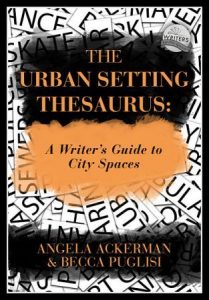The Urban Setting Thesaurus – A Writer’s Guide to City Spaces
(Angela Ackerman & Becca Puglisi)
This book is the latest offering from the ladies behind the Emotion Thesaurus, one of my most-read how-to write books.
The Urban Setting Thesaurus starts with a discussion of how to use setting to assist with characterisation and back story. This leads into a section on how to use the sensory details of the setting to draw the reader into the story.
I agree with the writers that the use of setting in this way is often overlooked, with plot and characters usually being the key considerations. This section of the book has a lot of good advice on letting the setting do some work for you, and how to integrate relevant aspects of the setting into the action.
The main body of the work is a thesaurus of specific urban locations. These are split into categories: In the City (locations such as the bank, the courtroom, and a hotel room, Restaurants (such as a coffeehouse, diner, and fast food restaurant), Retail stores (such as a flower store and pet store), and Entertainment venues (such as an art studio and museum).
Each specific setting has a list of many sensory details, split by the five main senses. Following this is a list of possible sources of conflict in the setting, people commonly found in the setting, some tips on the setting, and a brief written example.
A sister volume to the book, the Rural Setting Thesaurus, is also available.
I think this book will be a very useful addition to my collection of writing tools. The discussion on using the sensory details of the setting to enhance the characterisation already has me thinking about how I can improve my writing.
The wide variety of settings included in the book mean have covered most of the settings I can think of. It’s very comprehensive.
My only caveats would be that the urban settings are predominantly contemporary, and some have an American slant.
So if you are writing a contemporary novel in another country, you may need to adapt the setting. For example, sporting event stands in the book are focused on American sports, whereas, if I, a Brit, were writing about a sports stand, I would be more likely to refer to football scarves than pom-poms.
If you are writing a historical novel, you may find only the basics helpful, as many of the settings would not be appropriate. I’m writing fantasy, and in that respect, it will depend on the tech level and type of your fantasy setting as to whether you will be able to make use of it. I have an urban setting in my current work in progress, but I would, for example, have to substitute my magical glow globes for fluorescent lighting. If you write contemporary urban fantasy, however, the book would suit with minor tweaking.
If you are writing a contemporary romance, thriller, crime or literary work, however, this book will be invaluable.
The Urban Setting Thesaurus and it’s sister volume, The Rural Setting Thesaurus, will be available from Amazon on June 13th! For more details, check out the Writers Helping Writers blog.
(Note: I received an ARC of this book, but this is my honest review!)



Thank you for sharing your review of this book! I’ve enjoyed their previous works (emotion thesaurus!!!), so I need to check this one out sometime.
Great review! I’m so excited you got chosen for an ARC.
Looks very useful! I have to say, this is an area I’m lacking in.
Thanks for sharing this review, Elise. The Emotion Thesaurus and Emotion Amplifiers were awesome books with loads of useful suggestions. I’ll check this one too.
Thanks so much for taking the time to review–we always love to read what others think because we’re too close to it, you know? I hope writers find these helpful. They can’t be all things to everyone, but hopefully they will be what people need to give their minds and nudge and then they can tailor everything to their own world and characters. 🙂 Thanks again–really appreciate it!
You’re welcome 🙂